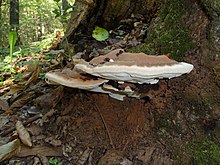树舌灵芝
灵芝科灵芝属的一种真菌
(重定向自Ganoderma applanatum)
此條目翻譯品質不佳。 (2022年8月2日) |
| 这是一篇與真菌類相關的小作品。您可以通过编辑或修订扩充其内容。 |
树舌灵芝(學名:Ganoderma applanatum)[1],俗稱老牛肝[來源請求],是一个具有世界性分布的支架真菌。
| 树舌灵芝 | |
|---|---|

| |
| 科学分类 | |
| 界: | 真菌界 Fungi |
| 门: | 担子菌门 Basidiomycota |
| 纲: | 傘菌綱 Agaricomycetes |
| 目: | 多孔菌目 Polyporales |
| 科: | 靈芝科 Ganodermataceae |
| 属: | 靈芝屬 Ganoderma |
| 种: | 树舌灵芝 G. applanatum
|
| 二名法 | |
| Ganoderma applanatum | |
| 異名 | |
| |
| Ganoderma applanatum | |
|---|---|
| 子實層上有萌發孔 | |
| 無明顯蕈傘 | |
| 子實層自基部沿蕈柄向下生長 | |
| 無蕈柄 | |
| 孢印褐色 | |
| 寄生真菌 | |
| 不可食 | |
整个孢子体可高达30—40厘米(12—16英寸),质硬,木质纹理;它们起初生长时是白色,但很快就变成深红褐色。棕色孢子将从子實體的下侧的气孔释放出来。子实体是多年生植物,可能持续多年,随着尺寸增加,气孔将形成新层。
它是一种木腐真菌,主要生長在死木材,也可作为活树木的病原体,特别在较老的树木。它是山毛榉和杨树腐朽和死亡的常见原因,并是对其他几个树属腐朽和死亡的较少经常的原因,包括桤木属,苹果属,榆树属,七叶树属,槭属(枫树),栎属(橡木),胡桃木,柳树,西部铁杉,花旗松,和云杉属。
这种真菌的特点在于它是作为艺术家的绘画介质的能力。当其表面被用锋利的工具摩擦或刮花,它从浅色变为暗褐色,产生可见的线条和阴影。
医用
编辑树舌灵芝在日本被称为「粉吹猿腰掛」(コフキサルノコシカケ kofuki-saru-no-koshikake)[2][3],字面意思是“粉覆盖猴子的长椅”。而在中国,长期以来一直用于传统药物[4]。研究表明,灵芝富含三萜类等化合物[5][6][7],在抗氧化,抗癌,抗血脂,抗细菌[8][9],抗肝纤维化[10],和抗抑郁等方面均有效果。不过灵芝能否作为营养膳食的补充剂,还是仅仅能作为药物用于治疗特定的疾病仍存在争议[11]。
参考资料
编辑- ^ Overson, Alissa. Ganoderma applanatum: The Artist's Conk. The Fungal Kingdom. Evergreen State College. [3 March 2016]. (原始内容存档于2015-01-12).
- ^ kofuki- saru-no-koshikake (コフキサルノコシカケ). Flora of Mikawa. [3 March 2016]. (原始内容存档于2020-10-30).
- ^ Mizuno, Takashi. Sarunokoshikake: Polyporaecea fungi‐kofukisarunokoshikake, ganoderma applanatum and tsugasarunokoshikake, fomitopsis pinicola. Taylor & Francis Online.
- ^ About Asian Anti-Cancer Materia Database. http://asiancancerherb.info/. [2017-07-01]. (原始内容存档于2018-01-02).
- ^ MIZUNO, TAKASHI; et al. Isolation and characterization of antitumor active β-d-glucans from the fruit bodies of Ganoderma applanatum. Elsevier Science Publishers B.V., Amsterdam - Printed in The Netherlands. [3 March 2016]. (原始内容存档于2016-03-08).
- ^ Taichi Usui et. al. Antitumor Activity of Water-Soluble β-D-Glucan Elaborated by Ganoderma applanatum. Taylor & Francis Online. [5 March 2016].
- ^ Applanoxidic acids A, B, C and D, biologically active tetracyclic triterpenes from Ganoderma applanatum. Phytochemistry. 26 March 1991, 30 (12, 1991): 4105–4109 [2017-07-01]. doi:10.1016/0031-9422(91)83476-2. (原始内容存档于2017-05-10).
- ^ Antibacterial Activity of Steroidal Compounds Isolated from Ganoderma applanatum. International Journal of Medicinal Mushrooms: 325–330. [2017-07-01]. doi:10.1615/IntJMedMushr.v1.i4.40. (原始内容存档于2020-02-07).
- ^ Exopolysaccharide from Ganoderma applanatum as a Promising Bioactive Compound with Cytostatic and Antibacterial Properties. BioMed Research International. July 2014, 2014: 1–10 [2017-07-01]. doi:10.1155/2014/743812. (原始内容存档于2020-01-06).
- ^ Luo, Q; Di, L; Dai, WF; Lu, Q; Yan, YM; Yang, ZL; Li, RT; Cheng, YX. Applanatumin A, a new dimeric meroterpenoid from Ganoderma applanatum that displays potent antifibrotic activity. Org. Lett. February 23, 2015, 17: 1110–3. PMID 25706347. doi:10.1021/ol503610b.
- ^ Galappaththi, Mahesh C. A.; Patabendige, Nimesha M.; Premarathne, Bhagya M.; Hapuarachchi, Kalani K.; Tibpromma, Saowaluck; Dai, Dong-Qin; Suwannarach, Nakarin; Rapior, Sylvie; Karunarathna, Samantha C. A Review of Ganoderma Triterpenoids and Their Bioactivities. Biomolecules. 2022-12-22, 13 (1). ISSN 2218-273X. PMC 9856212 . PMID 36671409. doi:10.3390/biom13010024 (英语).
外部链接
编辑- 树舌灵芝在Index Fungorum中的資訊
- Mushroom Observer:Observations of Ganoderma applanatum
